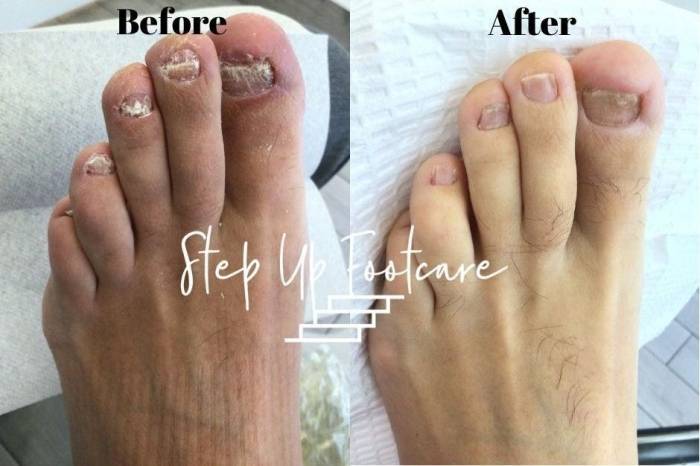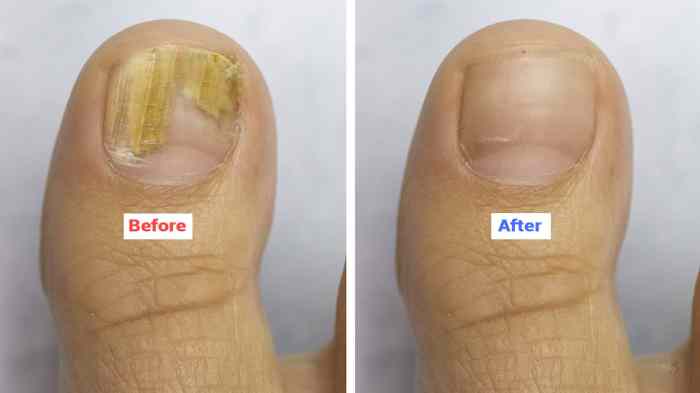Does Nail Polish Cause Nail Fungus?
Nail Polish and Nail Fungus: A Comprehensive Look

Source: medium.com
Does nail polish cause nail fungus – The relationship between nail polish and nail fungus is a complex one, often debated among dermatologists and nail technicians. While nail polish itself doesn’t directly
-cause* fungal infections, certain ingredients, application techniques, and removal methods can create an environment more susceptible to fungal growth. This article explores the potential links between nail polish use and nail fungus, examining various factors influencing the risk.
Nail Polish Ingredients and Their Potential Impact
Many nail polish components, while generally safe for topical use, might indirectly contribute to nail fungus development. The airtight seal created by polish can trap moisture and create a dark, warm environment – ideal for fungal proliferation. Certain ingredients, like formaldehyde and toluene, although regulated, may irritate the nail plate, potentially making it more vulnerable to infection.
Gel and acrylic nails, while offering longer-lasting color, pose additional risks. The application process involves the use of UV lamps, which, according to some studies, might contribute to nail dryness and weakening, increasing susceptibility to fungal infections. The prolonged application of these products also reduces the nail’s ability to breathe, further promoting fungal growth.
The chemical properties of common components, such as phthalates and camphor, are still under investigation for their long-term effects on nail health and their potential interaction with fungal spores. Further research is needed to fully understand the extent of their influence.
Hygiene Practices and Nail Fungus Risk, Does nail polish cause nail fungus
Improper nail polish application techniques significantly increase the risk of fungal infections. Contaminated tools, unsterile surfaces, or improper nail preparation can introduce fungal spores to the nail bed. Failing to remove nail polish regularly allows for the build-up of moisture and debris, creating a breeding ground for fungi.
- Always start with clean, dry nails.
- Use clean, disinfected tools.
- Avoid touching the nail bed with the brush.
- Remove nail polish regularly and thoroughly clean tools with alcohol.
Preventive measures, such as keeping nails trimmed and clean, and practicing good hygiene during manicures and pedicures, are crucial in reducing the risk of nail fungus.
Nail Polish Removal and its Effects
Acetone-based removers, while effective, can be harsh on the nail plate, potentially leading to dryness, brittleness, and increased vulnerability to fungal infections. Acetone-free removers, although gentler, may not remove polish as effectively, potentially leaving residual polish that can harbor fungi.
Safe nail polish removal involves gentle application, avoiding harsh scrubbing or excessive soaking. Proper hydration of the nails after removal is also essential.
| Product Name | Active Ingredients | Acetone Content | Potential Impact on Nail Health |
|---|---|---|---|
| Acetone-based Remover A | Acetone, ethyl acetate | High | Drying, potentially damaging to the nail plate |
| Acetone-free Remover B | Ethyl acetate, propyl acetate | Low/None | Generally gentler, but may not remove polish completely |
| Oil-based Remover C | Various oils, emollients | None | Moisturizing, but may require multiple applications |
| Remover with added vitamins E & oils | Acetone, ethyl acetate, vitamin E, oils | Medium | Moderately drying but offers some moisturizing properties |
Existing Research and Studies

Source: powerofpositivity.com
The scientific literature on the direct causal link between nail polish use and nail fungus is limited. While studies have explored the impact of nail polish ingredients on nail health, conclusive evidence directly linking specific nail polish components to increased fungal infection rates remains scarce. Many studies focus on the impact of specific practices, such as improper hygiene during application and removal, rather than the polish itself.
Further research is needed to address the gaps in our understanding. A controlled study comparing nail fungus incidence in groups with varying nail polish use habits, controlling for other risk factors, would be valuable.
Individual Factors and Susceptibility
Individual factors significantly influence susceptibility to nail fungus. Individuals with weakened immune systems, pre-existing nail conditions like psoriasis or eczema, or those with diabetes are at higher risk. Certain lifestyle choices, such as frequent exposure to moisture or wearing tight-fitting shoes, also increase the risk.
Consulting a dermatologist or podiatrist is crucial for any concerns about nail health. Early diagnosis and treatment are key to preventing the spread of fungal infections.
Visual Representations
A healthy nail is typically smooth, pink, and firm. A nail affected by fungus might exhibit discoloration (yellowing, browning, or darkening), thickening, brittleness, separation from the nail bed (onycholysis), and a crumbly or distorted texture. The infected area may appear dull and opaque compared to the healthy, shiny surface of an uninfected nail.
Imagine a healthy nail as a smooth, uniformly pink and shiny surface. In contrast, a fungal infection might present as a yellowish-brown discoloration, particularly at the edges or under the nail plate. The nail surface might appear thickened, rough, and possibly separated from the nail bed in patches, with a noticeably altered texture – less smooth and more crumbly.
Quick FAQs: Does Nail Polish Cause Nail Fungus
Can I prevent nail fungus by simply using acetone-free nail polish remover?
While acetone-free removers are gentler on nails, they don’t entirely eliminate the risk of fungal infection. Maintaining good hygiene practices, such as thorough cleaning of tools and regular polish removal, remains crucial regardless of the remover type.
Does the color of nail polish affect the risk of nail fungus?
The color of nail polish itself doesn’t directly impact the risk of nail fungus. The risk is primarily associated with the ingredients and application/removal practices, not the pigment.
How often should I remove my nail polish to minimize fungal risk?
It’s generally recommended to remove nail polish at least once a week to allow your nails to breathe and reduce the potential for moisture buildup, which can contribute to fungal growth.















